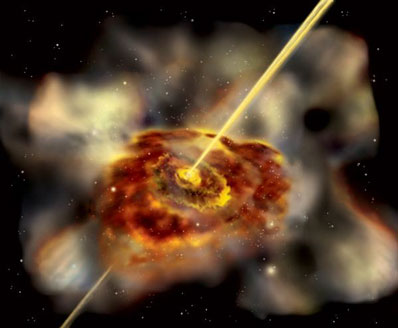
Direct address to this page:
https://www.hayadan.org.il/quazar0504.html
A new study claims that the brightest objects in the universe were born in relatively modest galaxies. The findings raise the possibility that supermassive black holes appeared en masse shortly after the Big Bang and grew faster than the galaxies around them.
Quasars are strange objects, brighter than the entire Milky Way galaxy. They are formed when supermassive black holes, whose mass exceeds one billion solar masses, devour the gas and stars around them.
Today, massive black holes are found only in massive galaxies, but most quasars were formed when the universe was about a third of its current age.
"These quasars, then, tell us what the progenitors of today's massive galaxies looked like in the early universe," says Mark Kukula, a quasar researcher at the University of Edinburgh in England who was not involved in the research.
The progenitors of the massive galaxies were smaller than the galaxies they became. An international team of astronomers studied nine quasars, located about 10 billion years away from us, with the help of the eight-meter telescope "Gemini North" in Hawaii. The light that reaches us, therefore, shows us them as they were, when the universe was less than 4 billion years old.
The astronomers filtered the light of the quasar itself in order to reveal the galaxies where the quasars are located. This is the most far-reaching study of quasar-hosting galaxies ever made. However, only one of these galaxies was bright enough to be seen, and that one galaxy was of medium size, similar to our own galaxy, the Milky Way.
The size limit surprised astronomers. "When you see something very bright, you expect it to be dramatic and huge in size," says team member Robert Smith of Liverpool John Moores University in England.
Furthermore, the team found no signs of merging galaxies, which are thought to ignite the beginning of the flow of matter into the supermassive black holes. Instead, Smith told New Scientist, a steady stream of gas appears to drive the cores of black holes.
Interestingly, quasars at the measured distances are 50 times brighter than younger quasars. "These galaxies, then, were more efficient at accreting matter than they are today, or the distant black holes are ten times more massive than the nearby ones," says Smith.
Smith and his team support the second explanation, but exactly how ancient black holes became so large in such a short period of time remains a mystery. "We have not discovered how such massive black holes were formed in the first generation of galaxies in the universe," he says.
Astronomers are now working on theories that would explain how this was possible in just tens or hundreds of millions of years. Some theories claim that black holes formed directly from gas without first forming stars, but more accepted models include the first generation of stars formed after the Big Bang.
These stars were very massive and had extremely short lifespans. They could have formed large black holes when they exploded in supernovae. "If the stars were formed in clusters, the black holes would have rapidly merged and grown to the masses that we see today in quasars," says Kokula.
Translation: Dikla Oren
The article in New Scientist
They knew astrophysics - stars and galaxies
https://www.hayadan.org.il/BuildaGate4/general2/data_card.php?Cat=~~~855301697~~~60&SiteName=hayadan
